For dedicated PC gamers, optimizing every component of their setup is crucial for performance and comfort. While a high-quality gaming keyboard is standard, a specialized gaming keypad can offer a more ergonomic and efficient control scheme for certain genres. These compact devices provide essential keys within immediate reach, often with advanced programmability and unique features not found on traditional keyboards.
This guide provides a purely informational, objective analysis of ten popular devices marketed toward gamers. The list includes true one-handed gaming keypads as well as compact and full-sized keyboards that are often considered in the same category. The goal is to present factual, up-to-date information to help users understand the options available in the current market.
Understanding the Landscape of Gaming Keypads & Keyboards
The term “gaming keypad” can be confusing, as it often encompasses a variety of form factors. It’s important to distinguish between them:
- One-Handed Gaming Keypads: These are small, auxiliary devices designed specifically for gaming. They feature a limited set of keys, often arranged ergonomically, and may include components like thumbsticks or scroll wheels. Their primary benefit is placing all critical game commands within a small, comfortable area, leaving more desk space for mouse movement.
- Compact Keyboards (TKL, 65%, etc.): These are smaller versions of standard keyboards. A Tenkeyless (TKL) board removes the number pad, while a 65% board also removes the function row and navigation cluster. While not dedicated keypads, their smaller footprint makes them a popular choice for gamers seeking more mouse real estate.
- Full-Sized Keyboards: These are standard 104-key keyboards. While offering maximum functionality, they take up the most desk space. Some models included in this analysis are full-sized but are marketed with gaming-specific features.
Comparative Analysis of Gaming Keypads and Keyboards (2025)
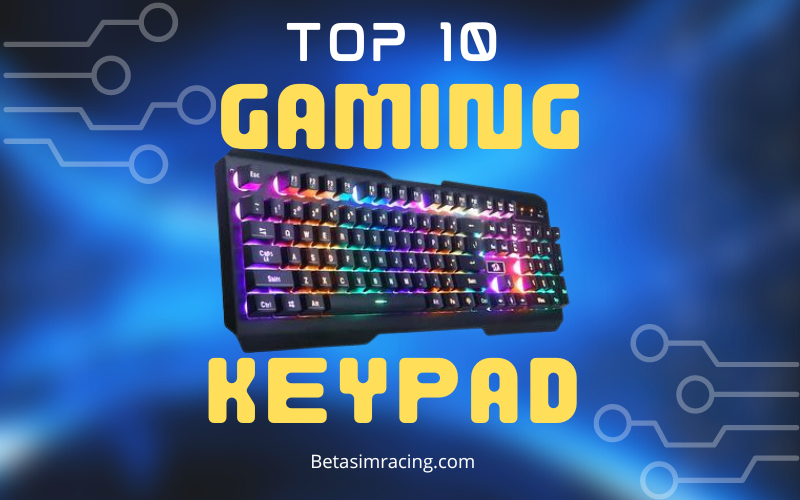
This table provides a high-level overview of the key specifications for each product reviewed in this guide. All information is based on the latest available data.
| Product | Type | Number of Keys | Switch Type | Programmable Keys | Connectivity | Wrist Rest | Backlighting | Special Features |
| Redragon K585 DITI | One-Handed Keypad | 42 | Mechanical (Outemu Blue) | 7 Macro Keys | Wired (USB-C) | Detachable, Magnetic | Per-key RGB | Macro Recording, USB Passthrough |
| BlueFinger Combo | Full-Sized Keyboard | 114 | Membrane | None | Wired (USB-A) | Integrated | 3-Zone Rainbow | Includes mouse and mousepad |
| Razer Tartarus Pro | One-Handed Keypad | 32 | Analog Optical | Fully Programmable | Wired (USB-A) | Integrated, Adjustable | Per-key RGB (Chroma) | 8-Way Thumbpad, Scroll Wheel |
| Logitech G413 SE | Full-Sized Keyboard | 104 | Mechanical (Tactile) | None (F-key media only) | Wired (USB-A) | None | White | PBT Keycaps, Aluminum Top Case |
| Redragon K506 Centaur | Full-Sized Keyboard | 104 | Membrane | None (Multimedia keys) | Wired (USB-A) | Integrated | 7-Color Rainbow | Splash-proof Design |
| ENHANCE Keypad | One-Handed Keypad | 35 | Membrane | 2 Macro Keys | Wired (USB-A) | Integrated | 7-Color LED | Spill-Resistant, Compact |
| KOLMAX K35 | One-Handed Keypad | 35 | Membrane | None | Wired (USB-A) | Integrated | RGB | Built-in Game Chip, Anti-Ghosting |
| Logitech G715 | TKL Keyboard | 87 | Mechanical (Logitech GX) | Fully Programmable | Wireless (Lightspeed/BT) | Detachable, Cloud-Soft | Per-key RGB | Volume Roller, Media Controls |
| Motospeed K27 | One-Handed Keypad | 27 | Mechanical | None (Multimedia keys) | Wired (USB-A) | Integrated | 9 LED Effects | High Keycap Ladder Design |
| JHUA One-Handed | One-Handed Keypad | 35 | Mechanical | Macro Support (Software) | Wired (USB-A) | Integrated | RGB | Curved Keycaps, N-Key Rollover |
Detailed Analysis of Top Gaming Peripherals
The following sections provide an objective breakdown of each product, based on its current specifications and features.
1. Redragon K585 DITI One-Handed Mechanical Gaming Keyboard
The Redragon K585 DITI is a dedicated one-handed gaming keypad that aims to provide all the essential gaming keys in a compact, ergonomic form factor. It is a popular option for gamers looking to transition from a full keyboard to a more specialized device.

Objective Analysis
The K585 features 42 keys, including a standard layout for movement and common in-game actions, plus a row of programmable macro keys. It uses Outemu Blue mechanical switches, which provide a tactile and audible “clicky” feedback. While this feedback is favored by some for its clear actuation point, it is noticeably louder than other switch types. The inclusion of a detachable USB-C cable adds a modern touch and makes for easier transport. The magnetic wrist rest offers added comfort but can detach if the keypad is moved abruptly.
Key Specifications
- Type: One-Handed Mechanical Keypad
- Connectivity: Wired, Detachable USB-C
- Switches: Outemu Blue (Clicky, Tactile)
- Keys: 42 total, with 7 programmable macro keys (up to 28 settings)
- Backlighting: Per-key RGB with multiple modes
- Features: Detachable magnetic wrist rest, onboard macro recording, USB 2.0 passthrough port
Pros & Cons
- Pros:
- Detachable USB-C cable enhances portability.
- Tactile and audible feedback from Blue switches can confirm key presses.
- Onboard macro recording allows for customization without software.
- Integrated wrist rest provides ergonomic support.
- Cons:
- Outemu Blue switches are loud and may be disruptive in shared spaces.
- Limited to 7 dedicated macro keys.
- Software for customization can have a learning curve.
2. BlueFinger RGB Gaming Keyboard and Mouse Combo
This product is a bundled package that includes a full-sized membrane keyboard, an optical gaming mouse, and a mousepad. It is marketed as an all-in-one starter kit for budget-conscious gamers.
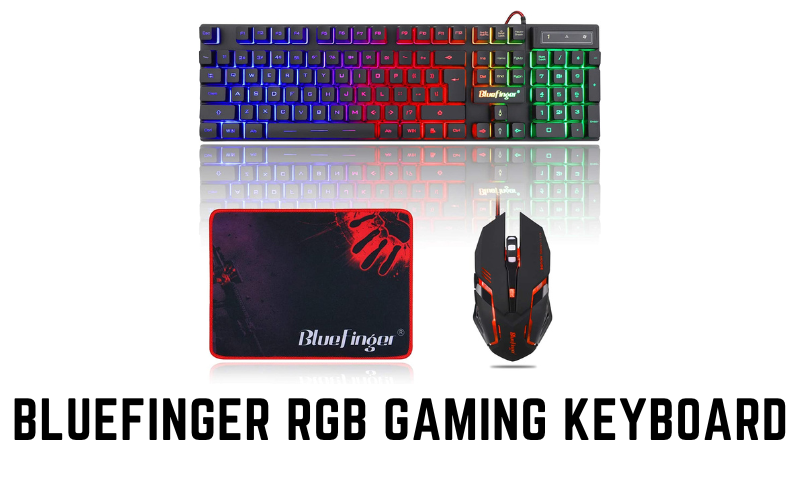
Objective Analysis
Unlike dedicated keypads, the BlueFinger keyboard is a full 114-key unit. It utilizes membrane switches, which results in a quieter, softer keypress compared to mechanical keyboards. However, membrane switches generally offer less tactile feedback and have a shorter lifespan. The keyboard features 19-key anti-ghosting, which allows for simultaneous presses of common gaming key combinations without issue. The included mouse has an adjustable DPI (up to 2000), which is a useful feature for matching sensitivity to user preference. The entire package is an entry-level solution and its construction is primarily plastic.
Key Specifications
- Type: Full-Sized Membrane Keyboard & Optical Mouse
- Connectivity: Wired, USB-A
- Switches: Membrane
- Keys: 114 keys with 10 multimedia keys
- Backlighting: 3-color static or breathing rainbow effect
- Features: Includes 6-button mouse (up to 2000 DPI) and a large mousepad.
Pros & Cons
- Pros:
- Complete starter package with keyboard, mouse, and mousepad.
- Quiet operation due to membrane keys.
- Dedicated multimedia keys provide convenient controls.
- Low price point makes it accessible for new builders.
- Cons:
- Membrane keys lack the tactile feedback and durability of mechanical switches.
- Not a specialized keypad; it’s a standard full-sized keyboard.
- Limited RGB customization (zone lighting, not per-key).
- No programmable macro keys.
3. Razer Tartarus Pro Gaming Keypad
The Razer Tartarus Pro is a high-end gaming keypad that features advanced switch technology. It is designed for gamers who require nuanced control and extensive customization for complex games like MMOs and RPGs.
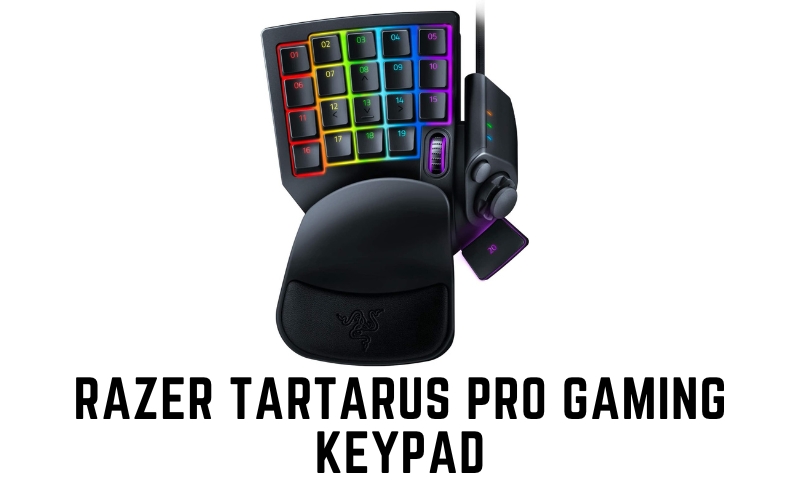
Objective Analysis
The standout feature of the Tartarus Pro is its use of Razer’s Analog Optical Switches. Unlike standard mechanical switches that have a binary (on/off) actuation, these switches can detect how far down a key is pressed. This allows for controller-like analog input, such as varying movement speed from a walk to a run. It also enables dual-function keys, where a half-press can trigger one action and a full press can trigger another. With 32 fully programmable keys, an 8-way directional thumbpad, and a scroll wheel, it offers immense control possibilities. These features are configured through Razer’s Synapse software.
Key Specifications
- Type: One-Handed Analog Optical Keypad
- Connectivity: Wired, USB-A
- Switches: Razer™ Analog Optical Switches
- Keys: 32 fully programmable keys
- Backlighting: Per-key RGB with Razer Chroma™
- Features: 8-way directional thumbpad, programmable scroll wheel, adjustable actuation, dual-function keys, unlimited macro length.
Pros & Cons
- Pros:
- Analog Optical switches allow for precise, variable input.
- Dual-function key assignments double the number of available actions.
- Highly customizable with 32 programmable keys and 8 quick-toggle profiles.
- 8-way thumbpad is excellent for movement or extra keybinds.
- Extensive RGB customization via Razer Chroma.
- Cons:
- Has a significant learning curve to utilize its features effectively.
- Higher price point compared to most other keypads.
- Dependent on Razer Synapse software for full functionality.
4. Logitech G413 Mechanical Gaming Keyboard
The Logitech G413 is a full-sized mechanical keyboard focused on delivering core performance in a durable package. An updated version, the Logitech G413 SE, is now the primary model available. This analysis focuses on the SE variant.
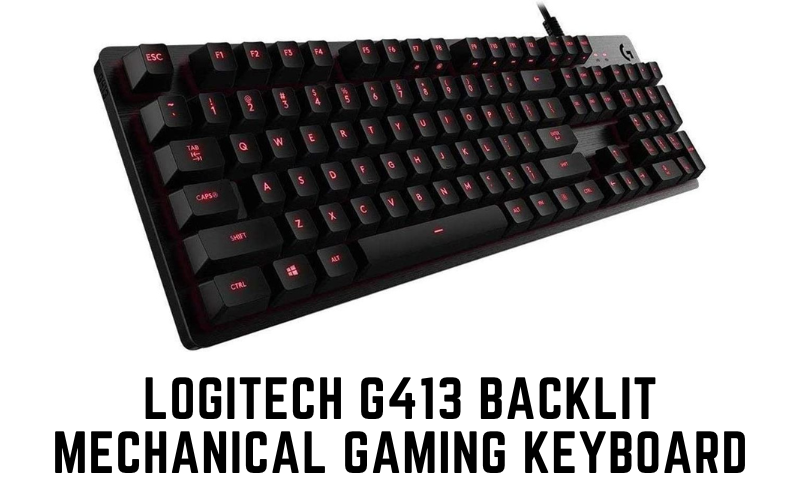
Objective Analysis
The G413 SE is not a keypad but a full 104-key keyboard. Its design philosophy is centered on durability and functionality. It features a black-brushed aluminum top case which provides significant rigidity and a premium feel. The keycaps are made from PBT (polybutylene terephthalate), a material known for its resistance to wear and shine over time. It uses tactile mechanical switches, providing a noticeable bump on actuation without the loud click of switches like the Outemu Blues. While it offers gaming-grade performance with 6-key rollover, it lacks the advanced programmability and RGB lighting of many competitors, featuring only static white backlighting.
Key Specifications
- Type: Full-Sized Mechanical Keyboard
- Connectivity: Wired, USB-A
- Switches: Tactile Mechanical Switches
- Keys: 104 keys
- Backlighting: White per-key lighting
- Features: PBT keycaps, 5052 aluminum alloy top case, 6-key rollover with anti-ghosting.
Pros & Cons
- Pros:
- Excellent build quality with an aluminum top case and durable PBT keycaps.
- Tactile switches offer good feedback for typing and gaming.
- Full-sized layout is suitable for users who need a number pad for productivity.
- Minimalist design aesthetic.
- Cons:
- Not a specialized gaming keypad.
- Lacks programmable macro keys.
- Backlighting is limited to white only.
- No integrated wrist rest.
5. Redragon K506 Centaur Gaming Keyboard
The Redragon K506 Centaur is another full-sized keyboard, designed for entry-level gamers. It uses membrane switches but is engineered to offer a more durable experience than typical office keyboards.
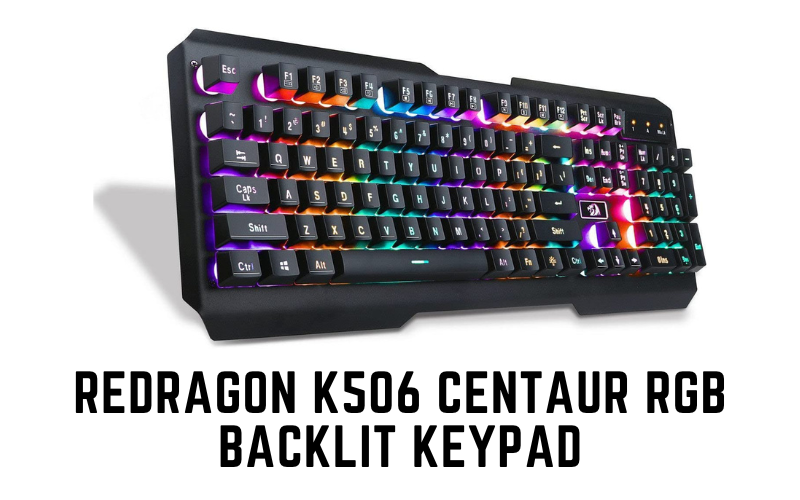
Objective Analysis
The K506 is a budget-oriented option that provides a full 104-key layout. Its primary material is a combination of ABS plastic and metal, giving it more heft than expected at its price point. It features custom membrane switches designed to be quiet during use. While it lacks true mechanical feedback, it does offer 26-key rollover (anti-ghosting) for common gaming combinations. The keyboard has a 7-color rainbow backlight with several effects, but it is zone-lit, meaning you cannot set individual key colors. Its splash-proof design is a practical feature that can protect against accidental spills.
Key Specifications
- Type: Full-Sized Membrane Keyboard
- Connectivity: Wired, USB-A
- Switches: Membrane
- Keys: 104 keys with 12 multimedia keys
- Backlighting: 7-color rainbow zone lighting with 10 modes
- Features: Splash-proof design, 26-key conflict-free operation, double-shot injection molded keycaps.
Pros & Cons
- Pros:
- Affordable price point.
- Quiet operation suitable for shared environments.
- Splash-proof design adds a layer of durability.
- Full-sized layout with a numeric keypad.
- Cons:
- Membrane switches lack the performance and feel of mechanical keys.
- Limited lighting customization (zoned, not per-key).
- No programmable macro functionality.
- Fonts on the keycaps can be stylized to a degree that may impact readability for some.
6. ENHANCE One-Handed Gaming Keypad
The ENHANCE Gaming Keypad is a compact, 35-key, one-handed device that prioritizes ergonomics and essential gaming controls. It is a membrane-based keypad aimed at gamers on a budget or those looking for a simple travel-friendly option.

Objective Analysis
This keypad provides the standard WASD layout and surrounding keys commonly used in FPS and action games. Its primary advantage is its small form factor and integrated wrist rest, designed for comfort during long sessions. It utilizes membrane switches, ensuring quiet operation. The unit includes two programmable macro keys, which can be configured for simple, repeated commands. A notable feature is its spill-resistant design with drainage channels, making it more resilient to accidents. The backlighting offers 7 solid colors and two dynamic effects, providing some aesthetic customization.
Key Specifications
- Type: One-Handed Membrane Keypad
- Connectivity: Wired, USB-A
- Switches: Membrane
- Keys: 35 keys with 2 programmable macro keys
- Backlighting: 7-color LED with 2 dynamic effects
- Features: Integrated wrist rest, spill-resistant design, braided cable.
Pros & Cons
- Pros:
- Ergonomic design with built-in wrist support.
- Spill-resistant feature adds durability.
- Compact and portable for travel or small desks.
- Simple macro functionality for basic commands.
- Cons:
- Membrane keys do not offer a tactile response.
- Limited programmability with only two macro keys.
- Build is primarily plastic.
- Can produce more noise than expected for a membrane keypad during intense use.
7. KOLMAX K35 One-Handed Gaming Keypad
The KOLMAX K35 is another example of a widely available 35-key, one-handed membrane keypad, often sold under various brand names. It’s designed to offer a basic, ergonomic gaming experience at an accessible price point.
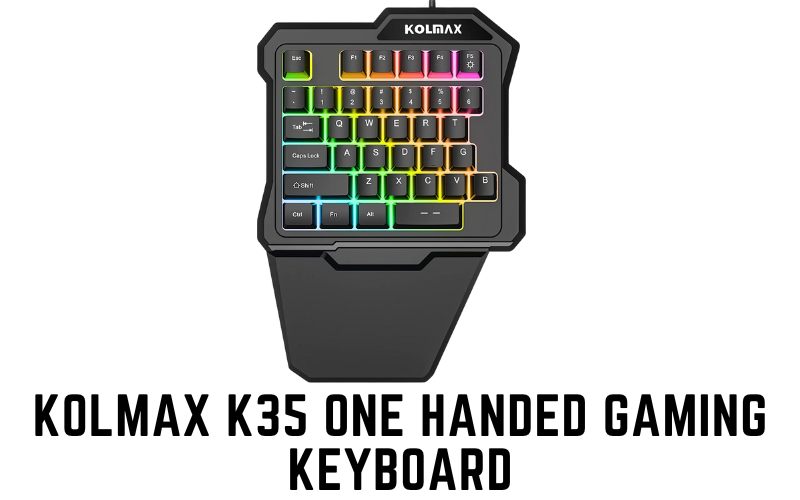
Objective Analysis
Functionally similar to the ENHANCE keypad, the K35 provides 35 essential gaming keys in a compact layout with an integrated wrist rest. It uses membrane switches that are designed to mimic the feel of mechanical keys, but they do not provide the same level of tactile feedback or actuation precision. The K35 boasts 35-key anti-ghosting, ensuring all presses register correctly during gameplay. The RGB backlighting offers multiple color modes, but customization is limited to cycling through presets rather than per-key control. Its main appeal is its portability and low cost, making it a viable option for laptop gamers or those with limited desk space.
Key Specifications
- Type: One-Handed Membrane Keypad
- Connectivity: Wired, USB-A
- Switches: Membrane (“Mechanical Feeling”)
- Keys: 35 keys
- Backlighting: Preset RGB modes
- Features: Integrated wrist rest, 35-key anti-ghosting, wide compatibility (PC, console support).
Pros & Cons
- Pros:
- Very affordable and widely available.
- Compact, space-saving design.
- Ergonomic form with an integrated wrist rest.
- Plug-and-play operation with no drivers required.
- Cons:
- Membrane keys do not offer a true mechanical experience.
- Lacks any programmable macro keys.
- The space bar can feel less responsive than other keys over time.
- Build quality is basic.
8. Logitech G715 Wireless Mechanical Gaming Keyboard
Part of Logitech’s Aurora Collection, the G715 is a premium TKL (Tenkeyless) wireless mechanical keyboard. It is not a one-handed keypad but appeals to gamers with its compact design, high-end features, and distinct aesthetic.
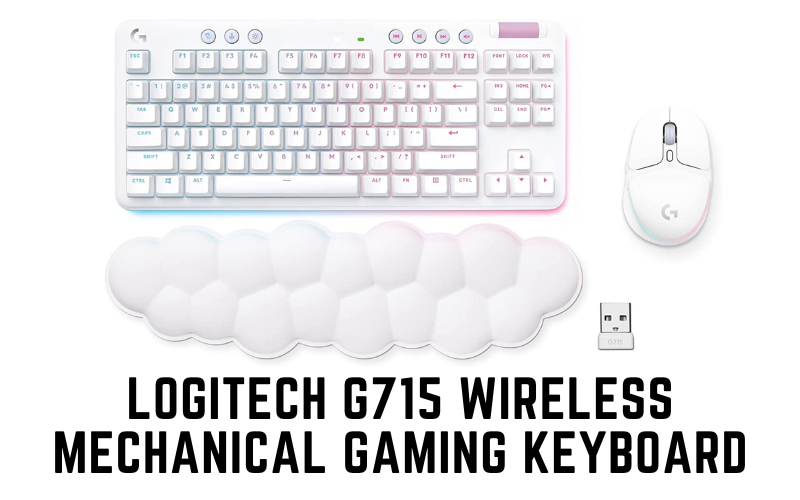
Objective Analysis
The G715 removes the number pad for a more compact footprint, freeing up significant desk space for mouse movement. It offers dual connectivity via Logitech’s gaming-grade LIGHTSPEED wireless or Bluetooth. Users can choose from Logitech’s own GX mechanical switches (Tactile, Linear, or Clicky) to suit their preference. The keyboard features a unique design with a “cloud-soft” detachable wrist rest and a White Mist finish. Full per-key RGB lighting is complemented by under-case perimeter lighting. It also includes dedicated media controls and a volume roller, features often absent on smaller keyboards. A key consideration for this product is its high-end positioning and price.
See Also: For more insights on Logitech’s peripheral ecosystem, a comparison like the Logitech G920 vs G29 can provide context on their product differentiation.
Key Specifications
- Type: TKL Wireless Mechanical Keyboard
- Connectivity: Wireless (LIGHTSPEED USB receiver or Bluetooth)
- Switches: Logitech GX Mechanical (Choice of Tactile, Linear, or Clicky)
- Keys: 87 keys
- Backlighting: Per-key LIGHTSYNC RGB + 16-zone perimeter lighting
- Features: Detachable palm rest, dedicated media keys and volume roller, double-shot PBT keycaps, rechargeable battery (approx. 30 hours).
Pros & Cons
- Pros:
- High-performance wireless connectivity.
- Premium build quality and comfortable wrist rest.
- Choice of high-quality GX mechanical switches.
- Dedicated media controls add convenience.
- Compact TKL form factor is ideal for gaming.
- Cons:
- Significantly more expensive than most other devices on this list.
- Not a one-handed keypad.
- Battery life requires regular charging.
- Aesthetic may not appeal to all users.
9. Motospeed K27 One-Handed Mechanical Gaming Keypad
The Motospeed K27 is a dedicated one-handed mechanical keypad that offers a no-frills, durable experience for gamers who prefer mechanical switches.
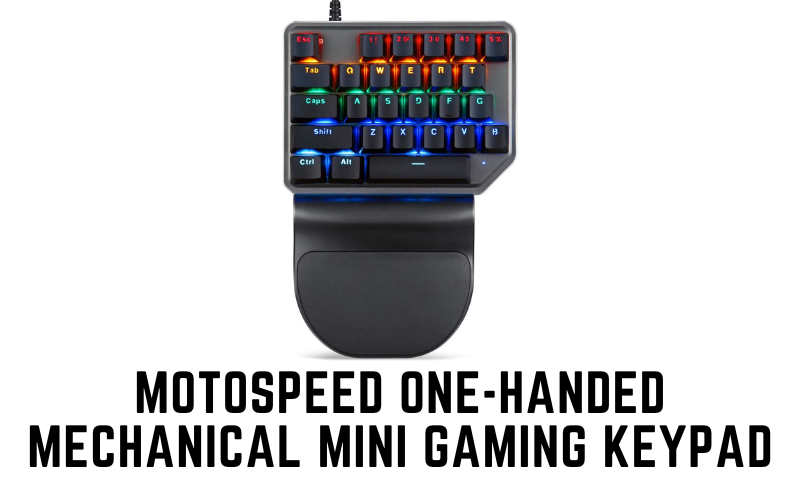
Objective Analysis
The K27 features a compact layout of 27 keys, focusing purely on the essentials for FPS and MOBA games. It utilizes mechanical switches, providing a more durable and responsive experience than membrane alternatives. The high keycap ladder design means the keys are tiered, which can contribute to a more ergonomic typing posture for some users. While it lacks programmable macro keys, it does have multimedia function key combinations. The backlighting consists of 9 different preset LED effects, offering some visual flair without the complexity of software-based customization. Its solid construction and mechanical keys make it a reliable choice for gamers who don’t need extensive programmability. For those interested in mechanical keys, understanding the variety of available options like Outemu switches can be beneficial.
Key Specifications
- Type: One-Handed Mechanical Keypad
- Connectivity: Wired, USB-A
- Switches: Mechanical
- Keys: 27 keys
- Backlighting: 9 preset LED color effects
- Features: High keycap ladder design, integrated wrist rest, multimedia function keys.
Pros & Cons
- Pros:
- True mechanical switches offer good durability and response.
- Compact and portable design.
- Simple plug-and-play functionality.
- Sturdy build for its category.
- Cons:
- Lacks any programmable keys or dedicated macro support.
- The mini size may feel cramped for users with larger hands.
- Integrated wrist rest is not adjustable.
10. JHUA One-Handed RGB Mechanical Keyboard
This device, often sold under various brand names, is a 35-key one-handed keypad that uses mechanical switches. It aims to combine the ergonomic benefits of a keypad with the performance of mechanical keys.
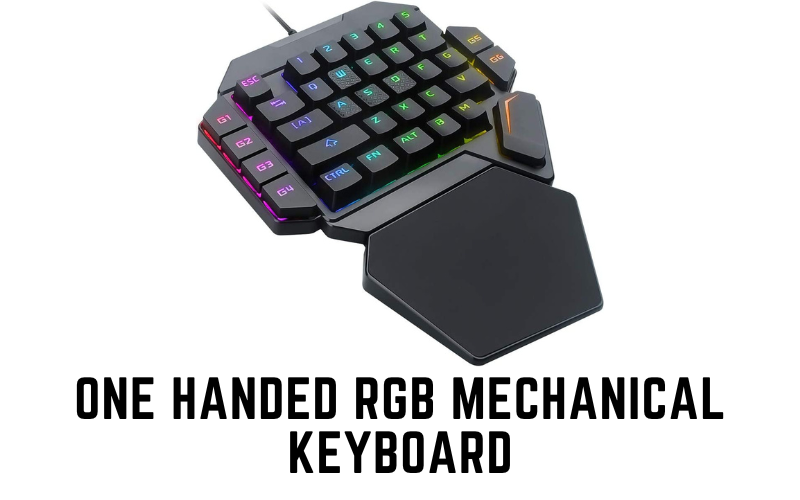
Objective Analysis
This keypad offers a layout similar to the membrane-based K35 and ENHANCE models but with the significant upgrade of mechanical switches. This provides a superior tactile feel and faster response for gaming. It features 35 non-conflict keys, allowing for reliable N-key rollover. The curved keycap layout is designed to fit the natural posture of the hand. While it lacks dedicated macro keys, it often supports software-based macro binding, allowing users to create custom commands. The RGB lighting is customizable through software, offering more flexibility than preset-only models. Its combination of mechanical keys and programmability in a one-handed form factor makes it a compelling option in the budget-to-mid range.
Key Specifications
- Type: One-Handed Mechanical Keypad
- Connectivity: Wired, USB-A
- Switches: Mechanical (Switch type can vary by seller)
- Keys: 35 non-conflict keys
- Backlighting: Customizable RGB
- Features: Integrated wrist rest, ergonomic curved keycaps, software support for macros.
Pros & Cons
- Pros:
- Mechanical switches provide a good gaming experience.
- Ergonomic design is comfortable for long sessions.
- Supports macro programming via software.
- N-key rollover ensures all presses are registered.
- Cons:
- Quality and switch type can be inconsistent as it’s often sold by various generic brands.
- Software can be difficult to find or use.
- Not suitable for keyboard shortcuts that require keys outside its 35-key layout.
Informational Guide: Selecting the Right Gaming Peripheral
Choosing between these different devices requires an understanding of your personal needs and gaming habits. This section breaks down the key factors to consider.
Defining Your Needs: Keypad vs. Compact Keyboard
Your choice largely depends on your primary use case.
- A one-handed keypad (like the Razer Tartarus or Redragon K585) is a specialized tool. It’s ideal for gamers who play specific genres (MMOs, RPGs, creative sandboxes) that benefit from numerous, easily accessible keybinds and macros. They are less suitable for general typing.
- A compact or TKL keyboard (like the Logitech G715) is a versatile compromise. It provides an excellent gaming experience by freeing up desk space while retaining full typing functionality, making it a great all-in-one solution for both gaming and general use. Whether PC gaming is worth it for you might depend on finding such versatile peripherals that enhance both play and productivity.
Mechanical vs. Membrane Keys: What’s the Difference?
The type of switch under the keys is perhaps the most critical factor in performance and feel.
- Mechanical switches use an individual, spring-loaded mechanism for each key. They offer superior durability, a more satisfying tactile feel, and faster response times. They come in various types (linear, tactile, clicky) to suit different preferences.
- Membrane switches use a single rubber dome sheet that registers a keypress when a key pushes the top membrane layer down against the bottom layer. They are quieter and less expensive but can feel “mushy” and are less durable.
The Importance of Programmability and Macros
For many games, the ability to program keys is a significant advantage. A macro is a sequence of keystrokes and actions bound to a single key. This can simplify complex combos in a fighting game or repetitive crafting actions in an MMO. Devices like the Razer Tartarus Pro offer deep customization, while others offer simpler, onboard macro recording.
Ergonomics: The Role of Wrist Rests and Design
Long gaming sessions can lead to strain. An ergonomic design can help mitigate this.
Blockquote: Look for features like an integrated or detachable wrist rest, an adjustable height, and a key layout that matches the natural resting position of your hand. A comfortable setup is essential for both performance and long-term health.
Connectivity: Wired vs. Wireless
- Wired connections offer a stable, lag-free experience with no need to worry about batteries. The cable can, however, contribute to desk clutter.
- Wireless connections provide a cleaner setup and more freedom of movement. Modern gaming-grade wireless technologies, like Logitech’s LIGHTSPEED, have virtually eliminated latency issues, but these devices are typically more expensive and require charging.
Frequently Asked Questions (FAQ)
What is a gaming keypad used for?
A gaming keypad is a small, specialized keyboard used primarily for gaming. It consolidates essential gaming keys into an ergonomic layout, allowing for faster access to commands and leaving more desk space for mouse movement. They are particularly popular for games that require numerous keybinds, such as MMOs and strategy games.
Are gaming keypads better than keyboards for gaming?
This is subjective and depends on the user and the game. For certain games that benefit from many macros and an ergonomic layout, a keypad can offer a performance advantage. For gamers who also type frequently or play a wide variety of genres, a high-quality compact mechanical keyboard might be a more practical all-around choice.
What is the difference between a mechanical and membrane keypad?
The difference lies in the switch technology. A mechanical keypad uses individual spring-loaded switches for each key, offering better tactile feedback, durability, and response. A membrane keypad uses a single rubber sheet, resulting in a quieter, softer, but often less precise feel.
What are analog optical switches?
Found in devices like the Razer Tartarus Pro, analog optical switches use light to detect the position of the keypress. This allows them to measure how far a key is pressed, not just if it’s pressed. This enables controller-like analog input for more nuanced movement control.
Do professional gamers use gaming keypads?
While the majority of professional esports players in FPS titles tend to use compact (TKL) mechanical keyboards, some professionals and many high-level streamers in other genres (like MMOs or Fortnite) do use gaming keypads to optimize their keybinds and macros.
How many keys should a gaming keypad have?
There is no single answer. A keypad with 25-35 keys is generally sufficient for most FPS and MOBA games, covering movement, abilities, and common actions. For complex MMOs or simulation games, a keypad with more keys and advanced macro capabilities, like the 32-key Razer Tartarus Pro, might be more suitable.
Is a wrist rest important for a gaming keypad?
For any peripheral used for extended periods, a wrist rest is highly beneficial for ergonomic support. It helps maintain a neutral wrist posture, reducing strain and the risk of repetitive stress injuries. Most gaming keypads include an integrated wrist rest for this reason.

With 15 years of experience as a PC hardware technician, Ben brings a practical, hands-on approach to our PC Components section. He specializes in real-world testing and longevity analysis, explaining how components perform over time. His guides help readers understand the practical side of owning and maintaining a gaming PC.
